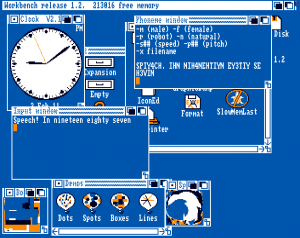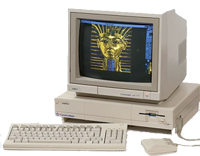Retrohomage: Amiga 1000
![]() The Amiga 1000 is the machine that, for me, really started “it” all. Originally just called the Amiga as, like Highlander, there can be only one, Commodore thankfully realised having model numbers might allow a little more flexibility and christened their first machine in the range the 1000…Â In this article, I try to explain why I believe it was such an important milestone in personal computing history.
The Amiga 1000 is the machine that, for me, really started “it” all. Originally just called the Amiga as, like Highlander, there can be only one, Commodore thankfully realised having model numbers might allow a little more flexibility and christened their first machine in the range the 1000…Â In this article, I try to explain why I believe it was such an important milestone in personal computing history.
 Launched in the USA in 1985 with atypical marketing extravagance, pizazz, and celebrity demonstrations that included the likes of Andy Warhol and Debbie Harry, I find it impossible to explain the revolution that this machine delivered to the personal computing marketplace. Take your pick of features from contemporary expectations and it was mind-blowing in what it delivered at the price point and, in some genres, at any price point. Base OS? Pre-emptive multi-tasking core. GUI? Rich WIMP interface. Graphics? up to 4096 colours on screen at a resolution of 320×256 through to 640×512, or even 768×576 with full overscan, plus sprites, coprocessor and blimmer (a blitter on steroids). Sound? Four independent 8 bit channels configured as a stereo pair. Processor? 7.x MHz 68000 from Motorola. Ports aplenty, including a comprehensive 86-pin expansion port that brought the 68000 bus and extra bits to the user.
Launched in the USA in 1985 with atypical marketing extravagance, pizazz, and celebrity demonstrations that included the likes of Andy Warhol and Debbie Harry, I find it impossible to explain the revolution that this machine delivered to the personal computing marketplace. Take your pick of features from contemporary expectations and it was mind-blowing in what it delivered at the price point and, in some genres, at any price point. Base OS? Pre-emptive multi-tasking core. GUI? Rich WIMP interface. Graphics? up to 4096 colours on screen at a resolution of 320×256 through to 640×512, or even 768×576 with full overscan, plus sprites, coprocessor and blimmer (a blitter on steroids). Sound? Four independent 8 bit channels configured as a stereo pair. Processor? 7.x MHz 68000 from Motorola. Ports aplenty, including a comprehensive 86-pin expansion port that brought the 68000 bus and extra bits to the user.
It’s also worth mentioning that typical launches had been at CES, or some other similar show: the big launch was, for Commodore, a new thing.
The previous Commodore machine was the 128, which was basically a 64 and another, more powerful 8 bit machine capable of 80 column graphics, more memory, and improved BASIC in a single box. The Amiga, developed by a small team with funding from Atari, was brought into the Commodore fold with a raised middle digit to Jack Tramiel, and then wisely left mostly alone and allowed to flourish.
 First thing that grabs me is the look: the 1000 aesthetic design is well executed. A slender box with separate keyboard, and space underneath for the keyboard to park overnight. The 128D had taken this approach, but the base unit had to be lifted up to store the keyboard… I have never understood that. A small concealed hatch at the front of the 1000 took a RAM expansion, a blanking plate covered the expansion port on the side… It all works remarkably well.
First thing that grabs me is the look: the 1000 aesthetic design is well executed. A slender box with separate keyboard, and space underneath for the keyboard to park overnight. The 128D had taken this approach, but the base unit had to be lifted up to store the keyboard… I have never understood that. A small concealed hatch at the front of the 1000 took a RAM expansion, a blanking plate covered the expansion port on the side… It all works remarkably well.
I am, you might conclude from this introduction, rather a fan.

